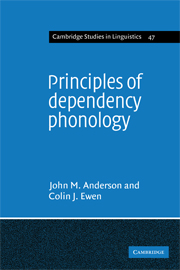5 - The categorial gesture: initiation
Published online by Cambridge University Press: 04 August 2010
Summary
In §II.2 we outlined some arguments which showed that what has been interpreted as a single phonetic component of phonation, i.e. ‘activities … described chiefly in terms of postures and movements of the vocal cords’ (Catford 1977:16), is phonologically relevant to more than one of the subdivisions of the categorial gesture. In particular, we showed that Ladefoged's (1971) scalar feature of [glottal stricture] can be given a more natural interpretation with respect to phonological phenomena if the two different phonetic parameters involved – degree of glottal stricture and presence or absence of vocal cord vibration – are separated, such that vocal cord vibration is characterised in the representations of the phonatory sub-gesture, while degree of glottal stricture proper is interpreted as being relevant to the other sub-division of the categorial gesture–the initiatory sub-gesture.
Our arguments in favour of this approach are given support by the phenomena surveyed in the previous chapter. As we have seen, what is crucial to the kind of hierarchies which we were able to establish in §§4.3 and 4.4 to account for lenition is the (privative) binary opposition between voicing and lack of voicing, i.e. between the presence and absence of vocal cord vibration, represented (at least for obstruents) by the presence vs. absence of a subjoined |V|. The physically independent parameter of glottal stricture, i.e. the degree of opening of the vocal cords, whether in vibration or not, appears to be phonologically relevant for three main types of languages.
- Type
- Chapter
- Information
- Principles of Dependency Phonology , pp. 185 - 205Publisher: Cambridge University PressPrint publication year: 1987



